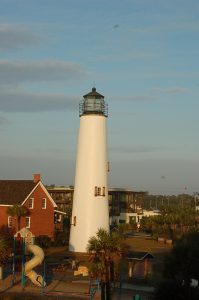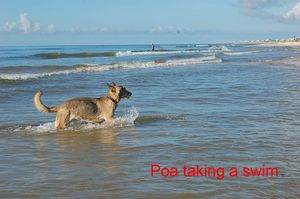
Measuring approximately 28 miles in length, St. George Island consistently rates as one of the top Beaches in the US. It is a Gulf Coast paradise offering miles of uninterrupted beautiful sand beaches St. George is one of the last inhabited, yet unspoiled, barrier islands of Florida. There are miles of uncrowded beaches for sunning and shelling, with clear Gulf waters for swimming, excellent fishing, and pristine marshes for wildlife viewing.
Dr. Beach once again voted the beaches on St. George Island one of the top 10 beaches in America!
Dr. Julian G. Bruce Saint George Island State Park offers nine miles of undeveloped beaches and dunes, surrounded by the Gulf of Mexico and Apalachicola Bay, provide the perfect setting for St. George Island State Park. Florida state parks are open from 8 a.m. until sundown 365 days a year.
No trip to St. George Island is complete without a visit to the 74-foot Cape St. George Lighthouse. Learn about the history at the lighthouse museum and then climb the 94 wooden steps and 8 rung ladder to the top!


1900 E. Gulf Beach Drive
Saint George Island, FL 32328
(850) 927-2111

Click the logo to learn more about each organization or to donate
St. George Island was first inhabited by the Creek Indians between the 10th and 15th centuries, who were all killed off by disease. With the arrival of European colonists to the area in the late 18th century came an intense struggle for control. In 1803, the Creek Indians ceded a large tract of land, which included St. George Island, to trader John Forbes and Company, known as the Forbes Grant.
St. George Island’s modern history began when in 1823 when John Lee Williams sought refuge there. With a shortage of food supplies, his crew depended on the island’s ample store of oysters and crabs. Soon afterwards, the island experienced a surge in trading activities especially along the banks of the Apalachicola River. This led to the construction of the central lighthouse on the island in 1833. It was used in those times as a navigational tool for incoming ships. However, it was destroyed in 2005 by a storm, much to the chagrin of native islanders. (The newly erected 79 foot St George Island Lighthouse stands proudly in the center of the island)
During the early and mid-20th century the island’s pine forest was used for turpentine production in naval stores.
During World War II, St. George Island was a practice range for B-24 bombers from nearby Apalachicola.
In 1954, the U.S. Army Corps of Engineers constructed the ship channel known as Bob Sikes Cut across St. George Island creating Cape St. George Island or “Little St. George Island” and enhanced its remoteness. The cut is used by the fishing fleet from Apalachicola and provides an access to the Gulf waters from the bay side.
In 1528 the first Spanish expedition of Panfilo de Narvaez passed through the area on its way from Tampa Bay to the Rio Grande. From the late 17th century through early 18th century a few passages referring to the area are mentioned. Carrabelle, Dog Island, and St. George Island served as points to stage raids on local ports as well as San Marcos de Apalache in 1677 and 1682.
In 1876 explorer Nathaniel Holmes Bishop of Medford, Massachusetts navigated the Crooked River through the lowlands to the Ochlockonee River. In 1877 Oliver Hudson Kelly, from Massachusetts founded the town and named it Rio Carrabelle. The following year the first U.S. Post office was established with its address as Rio Carrabelle. By 1881 the population was between 500 and 600 people.
In 1891 The Carrabelle, Tallahassee and Georgia Railroad was established to connect Carrabelle northward through Tallahassee to the Florida-Georgia line.
On August 1, 1899, the 2nd hurricane of the season struck the area almost destroying the town leaving just nine homes.
In 1942, Camp Gordon Johnston was opened for the purpose of training amphibious soldiers on nearby beaches. The camp trained a quarter of a million men and closed in 1946.
In 1898, David Brown, his wife Elizabeth Wood Brown, and their son, Herbert along with five other families left Georgia and traveled down the Chattahoochee River on a barge to Apalachicola, Florida. They settled across the Apalachicola Bay on the strip of land called Eastpoint.
The settlers established a group called the Co-Workers’ Fraternity which was concerned with spiritual, philosophical, and religious study, as well as a separate but related industrial colony focusing on economic production. Although individuals owned their land, the profits were shared among colony members. They engaged in farming, the seafood industry, and the lumber business.
Rebecca Wood Brown established the first Eastpoint post office which was located in their home until 1915. She served as postmistress from 1898 to 1938.
When the paddle wheel boat, Crescent City, began service between Apalachicola, Eastport and Carrabelle, more settlers arrived and Eastpoint soon became a booming fishing village. Mr. E.R.L. Moore built the Gulf Trading Company to ship fish and seafood to other parts of the country.
In 1915, roads were cut through to Carrabelle allowing mail and supplies to be transported on land. By 1932, a free ferry service was established making travel between Apalachicola, Eastpoint and Carrabelle more accessible.
The Cape St. George 65 foot tall lighthouse was first lit in December 20, 1848. The light was produced by 15 lamps with 16-inch reflectors. Unfortunately, this tower didn’t last very long. A hurricane in the fall of 1850 cracked and undermined the tower, and another hurricane in August of 1851 toppled Cape St. George lighthouse. In the summer of 1852, the present 74-foot tower was completed 250 yards further inland from the ruins of the old tower. Construction went quickly as two thirds of the brick from the ruins were salvaged and re-used. Cape St. George was extinguished with the start of the Civil War. In late 1861, a passing Union ship reported that the lens had been removed from the tower. After the war, the lens was found and the light was exhibited again on August 1, 1865. A new keepers dwelling was built in 1878. Soon after it was completed, hurricane driven waves passed over the island, damaging the tower and probably destroying the dwellings. Fuel for the light was changed to mineral oil in 1882 and later to incandescent oil vapor in 1913. The assistant keepers dwelling burned down sometime in the 1940’s. Finally in October 1949, the lighthouse was made automatic and unmanned. After many powerful hurricanes, the lighthouse was leaning and seemed doomed. Around 1995, the “Save The Light” campaign was started to raise funds to repair the lighthouse. Work was done and the lighthouse once again stood straight. But more storms and flooding took their toll and in 2005, the lighthouse collapsed. The St. George Lighthouse Association, established in 2004 to “rescue the light” worked with the State of Florida to salvage pieces of the lighthouse. The lighthouse was re-built in it’s current location and was re-opened in 2008.